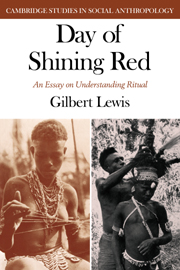Book contents
- Frontmatter
- Contents
- Analytical table of contents
- Preface
- 1 A question of interpretation
- 2 Problems of ritual in general
- 3 Views from one village
- 4 The rites of puberty seen
- 5 Rules of procedure and reflection on them
- 6 Silent forms but natural symbols?
- 7 Moon, river and other themes compared
- 8 For success in life
- 9 A choice of magic
- 10 Change and a rite falling into disuse
- 11 Inventory of themes
- References
- Index
- CAMBRIDGE STUDIES IN SOCIAL ANTHROPOLOGY
5 - Rules of procedure and reflection on them
Published online by Cambridge University Press: 30 October 2009
- Frontmatter
- Contents
- Analytical table of contents
- Preface
- 1 A question of interpretation
- 2 Problems of ritual in general
- 3 Views from one village
- 4 The rites of puberty seen
- 5 Rules of procedure and reflection on them
- 6 Silent forms but natural symbols?
- 7 Moon, river and other themes compared
- 8 For success in life
- 9 A choice of magic
- 10 Change and a rite falling into disuse
- 11 Inventory of themes
- References
- Index
- CAMBRIDGE STUDIES IN SOCIAL ANTHROPOLOGY
Summary
There is no doubt about whether or not someone has been through the puberty rite. It is done publicly on one day. The boy or girl is singled out, spat bright red all over, and decorated. A person must go through it once in his or her life. It is the first time that he or she must hold the centre of the public stage. During the spitting and decoration, the boy or girl seems bashful; gaze downcast, movement constrained. The others watch and when it is done the chatter breaks out again; there is excited horse-play and declarations of having done it right and well. It is an occasion which needs planning and organisation. Participants must be assembled, and meat, food and money made ready. There is bustle in the village on the day, an agreeable sense of a day set aside from ordinary work; special food, perhaps some extra touch of festive dress, plants and herbs to be found, the scent, the colour, the noise and chat.
First let me say something about those aspects of the rites dependent on the device of the marked stage. They stem from conventions about correct performance and who should take part. These set up a possibility for participation in the rites to be taken as an indicator of status and recognition, and for participation to be symptomatic of someone's sympathies and awareness of his obligations.
- Type
- Chapter
- Information
- Day of Shining Red , pp. 89 - 105Publisher: Cambridge University PressPrint publication year: 1980

